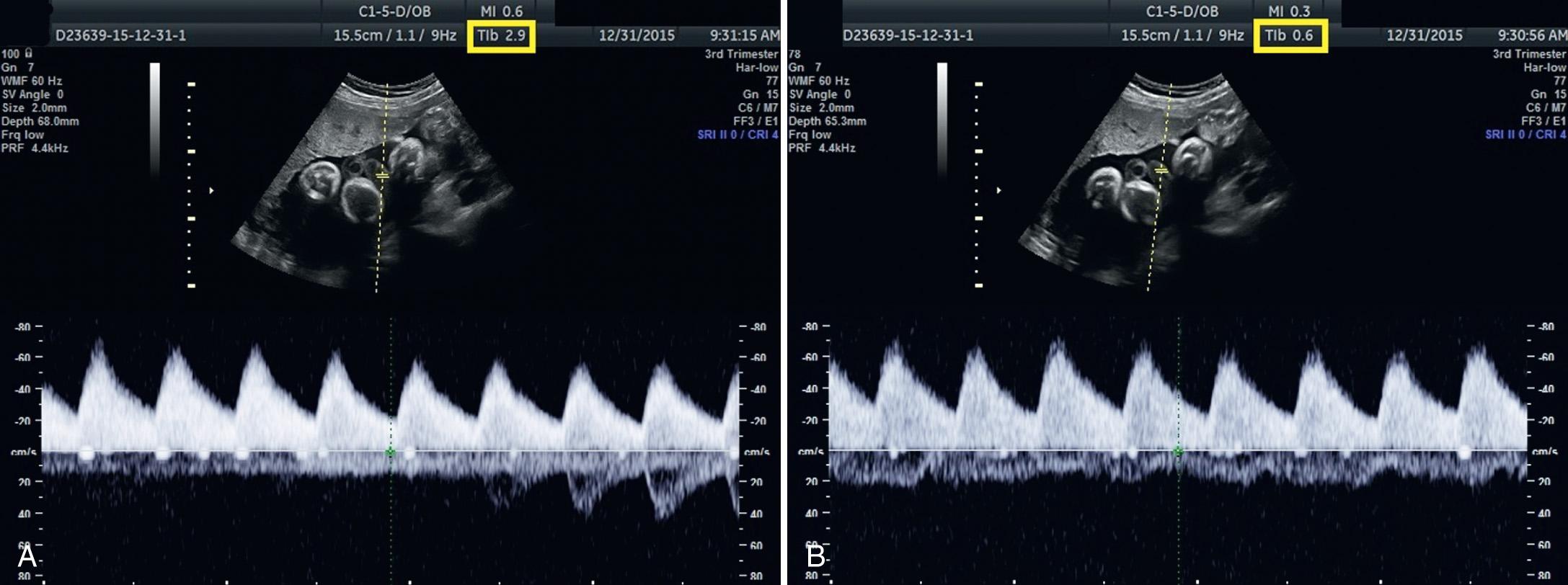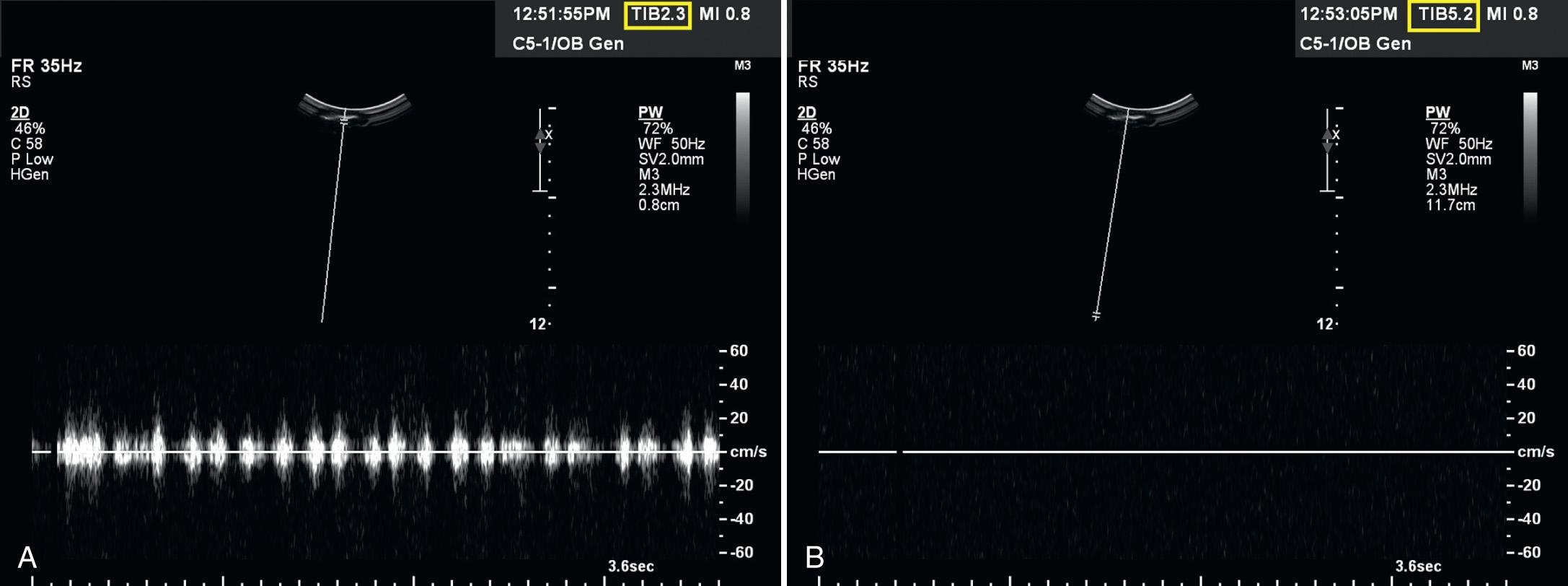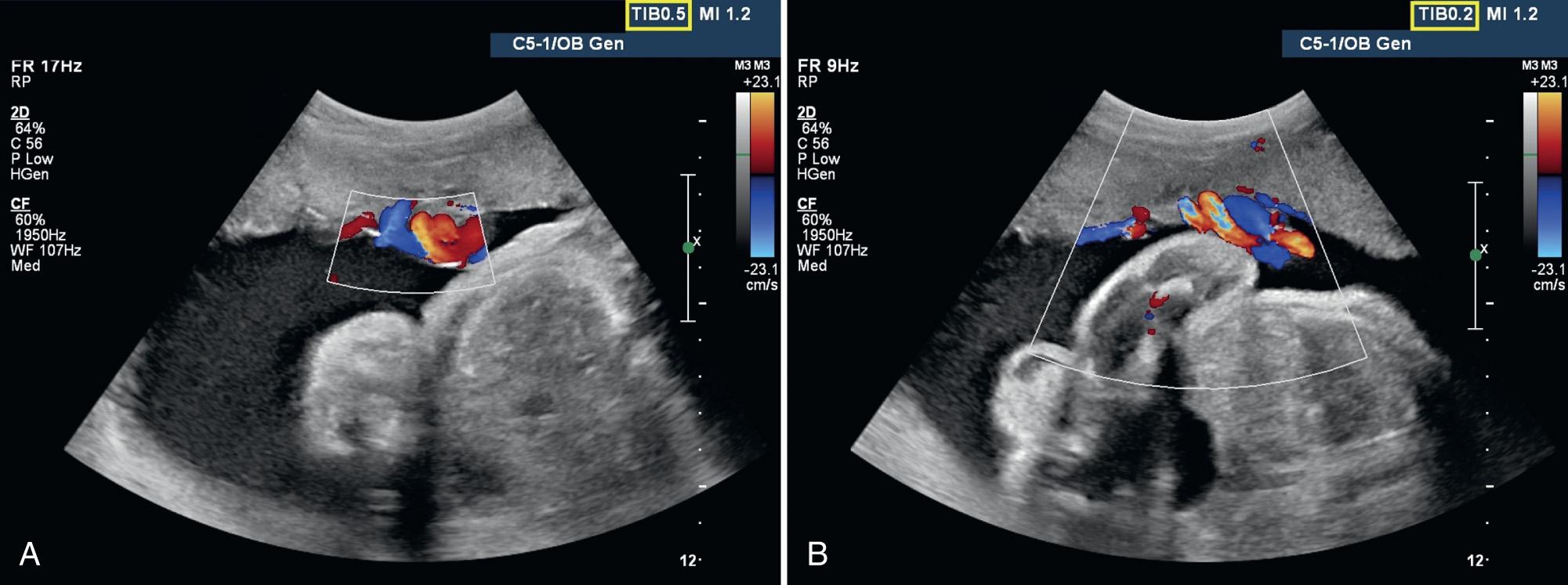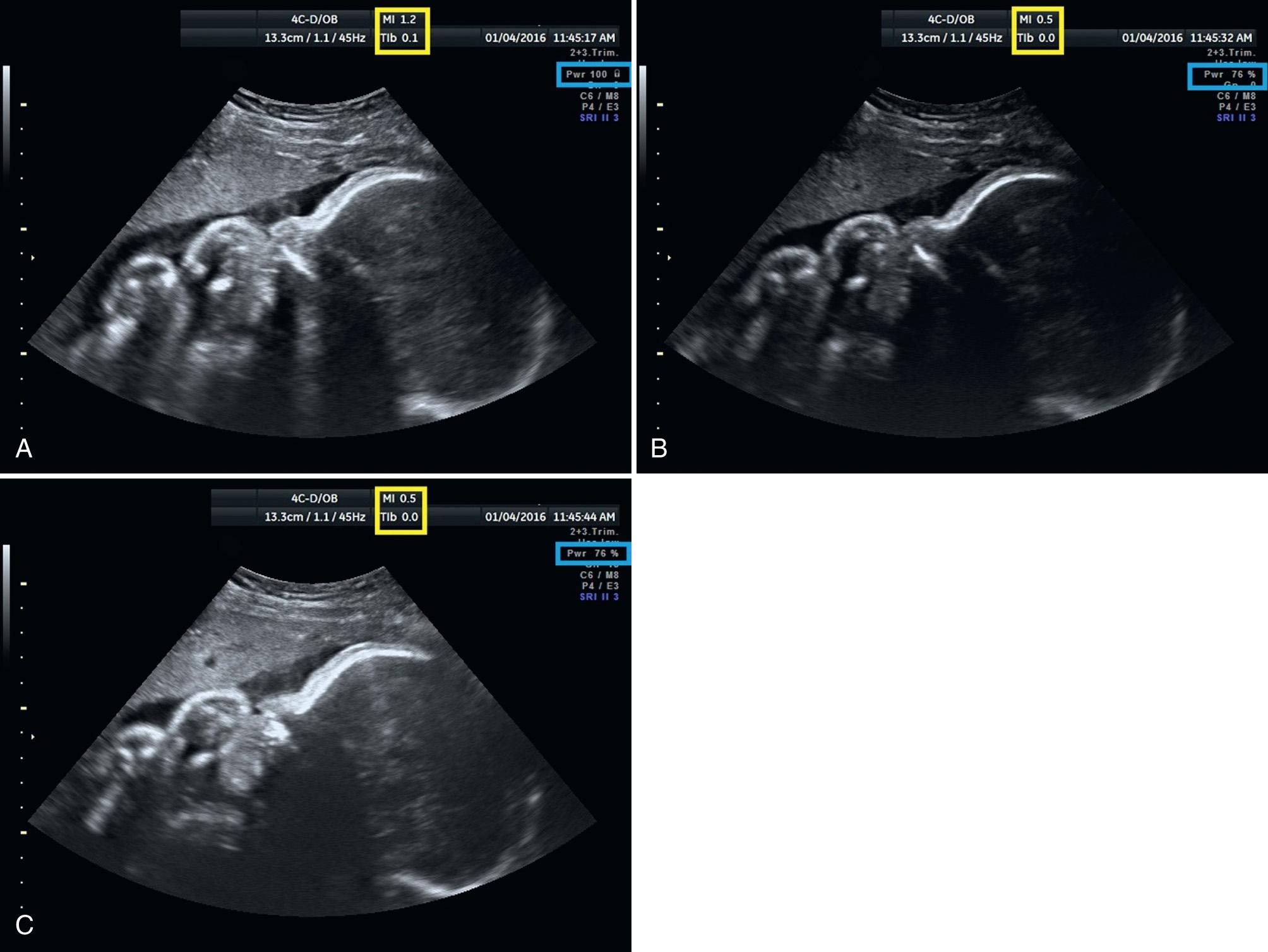Physical Address
304 North Cardinal St.
Dorchester Center, MA 02124
Obstetric ultrasound should only be performed with a clear indication, with calibrated machines, and by proficient professionals.
Know the specific machine being used (what causes increase in output power).
Keep the examination as short as possible and use the lowest possible output power but compatible with arriving at the correct diagnosis (as low as reasonably achievable [ALARA] principle).
Keep track of the onscreen thermal index (TI) and mechanical index (MI).
Keep the TI under 1.
Keep the MI under 1.
Start the scan at low power output and increase power only if necessary.
It is preferable to use gain compensation over increasing output power.
Be very cautious when using Doppler in the first trimester or in the immediate vicinity of bone.
More than half a century of extensive use in clinical obstetric and radiologic practice has shown that diagnostic ultrasound does not cause major abnormalities in the fetus. Ultrasound, however, is a form of energy and clinicians must consider whether subtle effects are possible when such energy penetrates living tissues. Although some effects have been described in animals, no immediate human correlation can be made. Conversely, “no effects detected so far” does not necessarily means “no effect.” Only large, epidemiologic studies can solve this problem. In the United States, most women who receive prenatal care are referred for at least one ultrasound scan; in many other countries, almost 100% of these women are exposed to ultrasound. In reproductive endocrinology, numerous scans are performed on the ovaries (and the follicles) and the very early developing embryo or fetus. Furthermore, multiple examinations are often performed during pregnancy, with or without clear indication. Because of this near-universal exposure of pregnant women and their unborn children to ultrasound, given its tremendous diagnostic value, the issues of possible effects and safety need to be addressed. The issue of whether short-term or long-term adverse bioeffects to the fetus may result from exposure to ultrasound has been raised since the beginning of the clinical use of this modality.
It is well established that under certain conditions, ultrasound can have undesirable side effects. This and the issue of safety have been discussed extensively in the literature. Two conflicting points need clarification: (1) to date, no evidence has been found of harmful effects of ultrasound in humans at clinical exposure levels, but (2) all available published epidemiologic data are from before 1992. Since then, acoustic output of diagnostic systems for fetal use was increased by a factor of almost 8, from 94 mW/cm 2 to 720 mW/cm 2 , and, in reality, a factor of 16 (from 46 mW/cm 2 ) based on earlier regulations. Additional concerns follow:
An increasing number of fetuses in the first trimester, a time of maximal susceptibility to external insults, are exposed to ultrasound, particularly spectral Doppler.
“Entertainment” ultrasound, scanning to obtain pictures or videos of the fetus (fetal “keepsake” videos) without a medical indication has burgeoned despite calls for avoidance of unnecessary exposure.
Clinical users of obstetric ultrasound appear to have limited knowledge and awareness of bioeffects and safety.
Thus the main goals of this chapter are as follows:
Summarize the literature on bioeffects in experimental settings as well as the available knowledge on bioeffects in the human fetus.
Analyze changes that occurred over time in energy levels of ultrasound machines and the regulations involved.
Describe how manipulation of many instrument controls alters acoustic energy and thus exposure.
Educate sonographers and physicians on how best to minimize fetal exposure without sacrificing diagnostic quality.
Over the years, output of ultrasound instruments has increased. Furthermore, many machine controls can alter the output, and various machines can behave differently when manipulating similar controls. For example, keeping in mind that the degree of temperature elevation is proportional to the product of the amplitude of the sound wave times the pulse length and the pulse repetition frequency, it becomes immediately evident why any change (augmentation) in these characteristics can add to the risk of elevating the temperature, a potential mechanism for bioeffects. Three important parameters under end-user control are the (1) scanning/operating mode (including transducer choice), (2) system setup and output control, and (3) dwell time.
When comparing modes, the spatial peak temporal average intensity (ISPTA) increases from B-mode (average, 34 mW/cm 2 ) to M-mode to color Doppler to spectral Doppler (average, 1180 mW/cm 2 ). Average ISPTA values are 1 W/cm 2 in Doppler mode but can reach 10 W/cm 2 . Caution is therefore recommended when applying this mode. Color Doppler has higher intensities than B-mode but is still much lower than spectral Doppler, mainly because of the mode of operation: sequences of pulses, scanned through the area of interest (“box”). High pulse repetition frequencies are used in pulsed Doppler techniques, generating greater temporal average intensities and power than B-mode or M-mode and thus greater heating potential. Also, because the beam needs to be held in relatively constant position over the vessel of interest in spectral Doppler ultrasound, temporal average intensity may further increase. This is particularly concerning in first-trimester applications. In addition, transducer choice is important because it will determine frequency, penetration, resolution, and field of view.
Starting or default output power is another important ultrasound parameter. Some manufacturers “boot” their machines with high power, which supposedly produces a better image, and the sonographer must act to decrease that power. Other systems boot up with low power and, only if judged necessary, the sonographer will increase that power. In, For example, the Doppler signal in Fig. 29.1A was obtained with a high power, as reflected by an elevated TI of 2.9, whereas in Fig. 29.1B the power was greatly reduced (TI = 0.6), and the image is still diagnostic. Also, the examiner fine-tunes to optimize the image, influencing output but with no visible effect, except to change thermal index (TI) and mechanical index (MI), as discussed in Chapter 2 .

Controls that regulate output include focal depth, usually with greatest power at deeper focus ( Fig. 29.2 ) but occasionally with highest power in the near field; increasing frame rate; and limiting the field of view, as by high-resolution magnification or certain zooms. In Doppler mode, changing sample volume and velocity range (to optimize received signals) will change output. In Fig. 29.3 , only the size of the color box is smaller, which caused increased TI on the output. It should be remembered that receiver gain often has similar effects as these controls on the recorded image (postprocessing), but no effect on the output of the outgoing beam (preprocessing), and therefore it is completely safe to manipulate. In Fig. 29.4A , the output power is high. In Fig. 29.4B , the output power has been greatly reduced (as reflected by a very low TI) and the image is much less diagnostic. In Fig. 29.4C , the receiver gain has been greatly increased, resulting in an image that looks identical to that in Fig. 29.4A but there were no changes in acoustic power, as reflected by unchanged TI and MI or power percentage. In other words, the receiver gain should be maximized before output is increased, which will rarely, if ever, be necessary.



Dwell time is the actual scanning time and thus directly under control of the examiner. Dwell time is not taken into account in the calculation of the safety indices and generally is not reported in clinical or experimental studies. However, it takes only one pulse to induce cavitation and about a minute to raise temperature to its peak. Directly correlated with dwell time is examiner experience, that is, the examiner's knowledge of anatomy, bioeffects, instrument controls, and scanning techniques.
That diagnostic ultrasound can induce thermal changes in various animals has been demonstrated. In addition, hyperthermia has clearly been shown to be teratologic to many species. Elevated maternal temperature, whether from illness or exposure to heat, can produce teratogenic effects. A rise less than 2°C is thought to be safe, although any temperature increase for any amount of time may have some effect, and a rise of 2.5°C may be considered significant. A major question is whether diagnostic ultrasound can induce a rise in temperature in the fetus that could reach dangerous levels. Temperature elevation in the human fetus cannot be exactly measured but can be estimated fairly accurately. For prolonged ultrasound exposures, temperature elevations of up to 5°C have been obtained. Thus any temperature increment for any period of time has some effect; the higher the temperature differential or the longer the temperature increment, the greater is the likelihood of producing an effect. Although these assumptions cannot be demonstrated in diagnostic ultrasound and no human data exist, clinicians should keep these facts in mind when performing obstetric ultrasound. This also forms part of the argument against nonmedical or nonindicated ultrasound examinations.
As with any external influence on the pregnancy, gestational age is a vital factor. Milder (in time or intensity) exposures during the preimplantation period (very early gestational age) could have similar or worse consequences than more severe exposures during embryonic and fetal development and could result in fetal demise and abortion or structural and functional defects. Such a dose analysis is not available. As for many other teratogens, the central nervous system (CNS) is most at risk because of a lack of compensatory growth by undamaged neuroblasts. In experimental animals the most common defects associated with temperature increase are of the neural tube (anencephaly, microencephaly) and the eyes (microphthalmia, cataract). Associated with CNS defects are functional and behavioral problems. Other organ defects secondary to hyperthermia include defects of craniofacial development (e.g., clefts) and anomalies of the axial and appendicular skeleton, the body wall, teeth, and heart.
Gestational age is critical when considering heat dispersion. In midterm, there was no significant difference when guinea pig fetal brains were exposed, alive (perfused) or postmortem (nonperfused), in the focal region of the ultrasound beam. However, a significant cooling effect of vascular perfusion was observed when the fetuses reached the stage of late gestation near term, when the cerebral vessels were well developed. In early human pregnancy, less than 6 weeks, the minimal fetal perfusion may reduce heat dispersion. The increased sensitivity of Doppler devices suggests evidence of blood flow within embryonic vesicles after heart formation, with the simultaneous development of a uterine circulatory pathway in the developing placenta. The flow is often referred to as “nonpulsatile” or “percolating” with near-minimal Doppler-measured velocities, as opposed to later in pregnancy. At about week 12 of gestation, the plugs of the spiral arteries are “loosened” and allow for freer blood circulation.
Thus perfusion status is far from approaching that for normal tissue levels (as assumed in the TI algorithm) for much of the first trimester. Only later, when “free circulation” is established (about week 11 or 12 of gestation), does the tissue become normally perfused, when the embryonic circulation actually links up with the maternal circulation. This absence of perfusion may result in underestimation of the actual ultrasound-induced temperature in early gestation. This warrants extreme caution in first-trimester scanning, particularly with the recent increase in utilization of Doppler in the first trimester.
Also, the issue of transducer heating may be particularly relevant in the first trimester, if performing endovaginal scanning. A mitigating factor is motion (even very small) of the examiner's hand, as well as the patient's breathing and body movements (in obstetric ultrasound, both mother and fetus), which tend to spread the region being heated. However, for spectral (pulsed) Doppler studies, it is necessary to have the transducer as steady as possible. Because the intensity and acoustic power associated with Doppler ultrasound are the highest of all the general-use categories, time spent scanning with Doppler ultrasound mode is crucial. Ziskin reported that average duration of 15,973 Doppler ultrasound examinations was 27 minutes (longest, 4 hours!). It is clear that temperature increases of 1°C are easily reached in routine scanning. Elevation of up to 1.5°C were obtained in the first trimester and up to 4°C in the second and third trimesters, particularly with the use of pulsed Doppler. In many clinical machines, TI values of 5 or 6 can be obtained in Doppler mode.
Become a Clinical Tree membership for Full access and enjoy Unlimited articles
If you are a member. Log in here